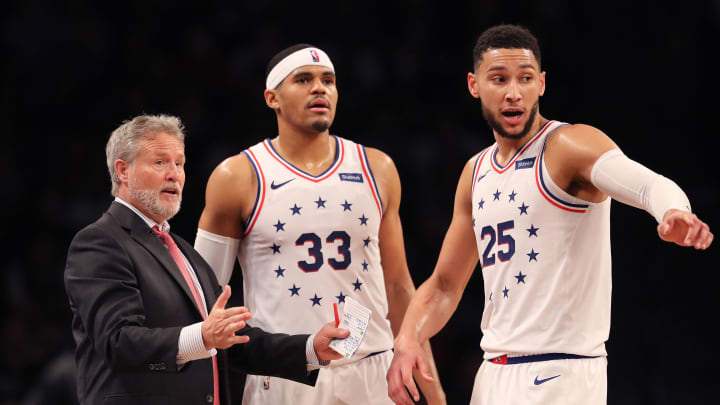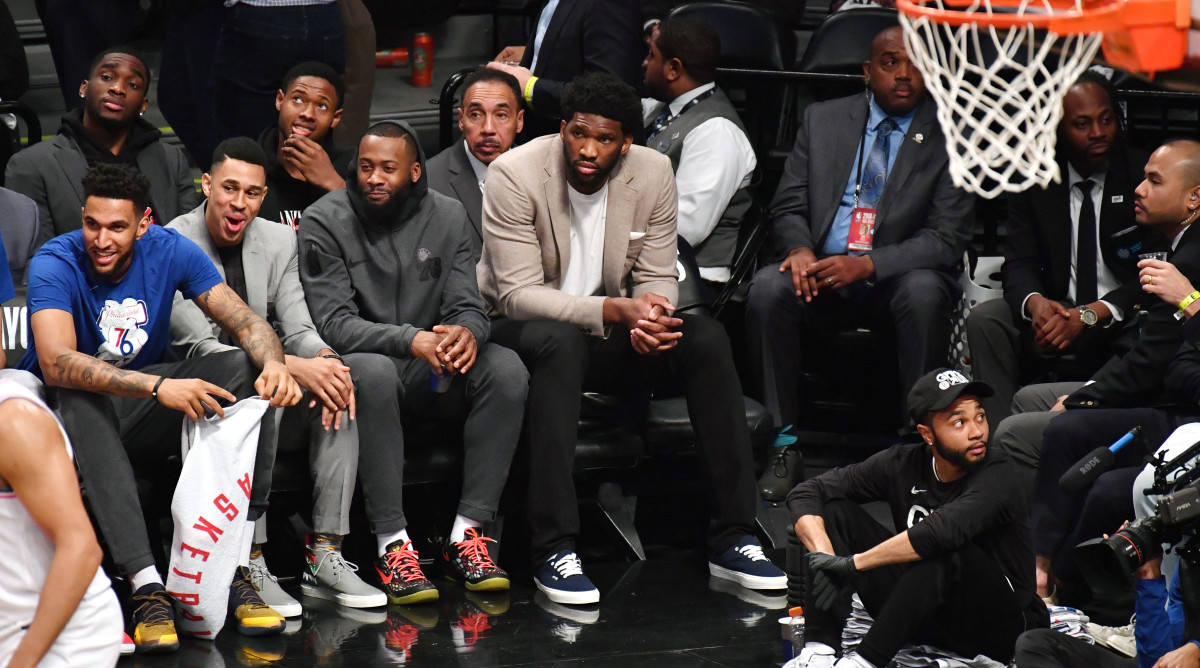The Sixers’ Blueprint to Keep Winning Without Joel Embiid

Ben Simmons put together a narrative-busting performance during the Sixers’ 131–115, Game 3 win over the Nets on Thursday. Simmons entered the contest under much attention—not only for his own uneven play during his short playoff career, but also because of growing tension between the two teams, and the last-minute absence of Joel Embiid. Simmons responded by putting his stamp on the win, recording 31 points, nine assists, and four rebounds while shooting 11-of-13 from the field.
The style of play was reminiscent of what Simmons did during arguably the most dominant stretch of his career, a 16-game winning streak at the end of last season, much of which came with Embiid injured. Though the team has changed considerably since that streak, two things looked the same between that Simmons-led squad and the one we saw Thursday night—pace and space.

Philly’s starting lineup doesn’t play particularly slow. Embiid isn’t an anchor, but he still commands touches in the post that inevitably shorten the flow of the game. When Embiid is out, the Sixers’ pace can reach crazy levels—which greatly benefits Simmons. Game 3 was played at a pace of 108, by far the highest of the series, and considerably faster than Game 1, which was Philly’s only loss. In general, the Sixers have played a totally different style of ball with Simmons on the floor and Embiid on the bench during the playoffs, with their pace increasing from 105.7 with the two sharing the court to 115.5 when it’s only Simmons. (Embiid’s sore knee undoubtedly playing a role in that stark difference.)
The sample sizes from Game 3 are incredibly small, but they support the overall picture. The starting lineup, with Greg Monroe in place of Embiid, played at a pace of 116.4. The group that effectively closed the door, with Mike Scott at center, was on the floor for only four minutes, but had a pace of 122.3. Okay, but why is this so important? Why have I said the word pace so many times that you want to find out where I live and dare me to say it again?
There’s some truth to what Jared Dudley said about Simmons—he’s more effective in transition than the halfcourt. When the Sixers are playing fast, defenses have less time to set against Simmons, and less time to muck up actions by sagging off his jump shot. It’s not that the Sixers can’t have an effective halfcourt offense, it’s that they are so much better when moving and attacking early in the shot clock. When Simmons is the unquestioned leader of the offense, he can dictate the speed the team is playing at. Instead of waiting for Embiid to battle for post position, he can immediately begin to barrel his way to the rim. (In Game 3, we also saw Simmons do more through handoffs and a brief appearance as the roll man.) Again, the Sixers aren’t necessarily better off without Embiid, but they can play a style most conducive to Simmons’s talents when he’s not playing.
So we’ve covered pace, but what about space? Last year’s Sixers were stacked with shooters in the starting lineup and on the bench, which meant Brett Brown’s rotations often featured lineups with Simmons surrounded by marksmen whenever Embiid needed a rest. In Game 3, it helped Philly immensely that Tobias Harris and J.J. Redick put together bounce-back performances from beyond the arc. Those two can’t be expected to shoot 11-of-15 from three every game. But Brown could (and probably should) go one step further to juice the offense, and start Scott at center in Game 4 instead of Monroe.
In the four minutes Simmons, Harris, Redick, Scott, and Jimmy Butler played together, Philly was a plus-seven, which was the best plus-minus of any lineup from Game 3, despite playing such limited time together. Scott didn’t even connect on a three Thursday night, but the threat of his shooting (especially compared to Monroe), opens the floor even more for Simmons. Removing obstacles from the paint only makes Simmons’s life easier.
With Monroe on the floor, the Nets have two defenders—their center, and whoever is sagging off Simmons—to more or less camp in the paint and wait for Philly to attack. The defense becomes less collapsable, and it’s easier to stick with shooters. Scott merely hanging around the perimeter gives Simmons more room to operate, and when Brooklyn is forced to help, it should ultimately create better looks for Philly’s shooters. The Sixers, as presently constructed, will never have the efficiency from outside as they did last year, but playing smaller more often brings them closer to “The Simmons Ideal.” (Scott also gives them some switchability on defense.)

So, if Philly knows the formula to win without Embiid—letting Simmons run and surrounding him with shooters—does that mean the big man should sit out the rest of the first round? There are pros and cons. On the plus side, it would probably help Simmons’s confidence—which certainly wasn’t lacking in Game 3—to lead a series victory on his own. Philly should be able to handle the Nets even without Embiid. Letting him rest could also theoretically get him healthy for later rounds, when his presence will be much more important. (Though Embiid has already missed plenty of time and doesn’t seem to be getting much better.) The biggest con is conditioning. Embiid quickly loses his game shape when he sits, and there were times during Games 1 and 2 when he looked a little heavy, and clearly didn’t have his full wind. Even if sitting Embiid were to magically return him to full health, the longer he’s out, the longer it would take for him to return to peak condition.
Where does all this end up? Philly should be able to handle the Nets, with or without JoJo in the lineup. Game 3 was a breakthrough night for Simmons, who proved his style of play can still lead to winning in the postseason, provided Brown is willing to let him play on his own terms. Embiid will absolutely be needed in the later rounds—he’s too great of a talent to suddenly become dispensable in stretch of the word, and the Sixers have had plenty of success whenever their starting five has been healthy. Ultimately, after a Game 1 scare, the Sixers have no reason to panic. They still have a transcendent talent in the lineup, and he’s now shown, in a real, live playoff game, what he’s capable of. Let Ben Simmons run wild, and Philly can still be a very dangerous team.
